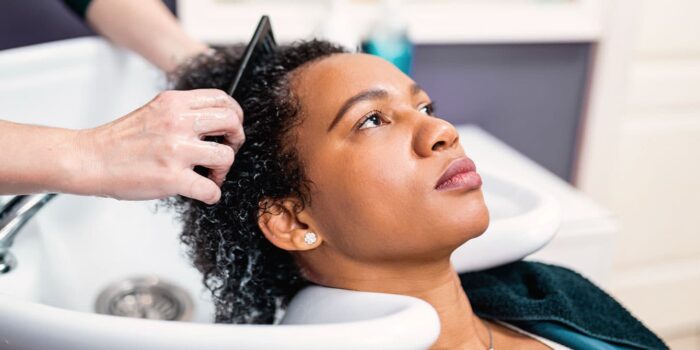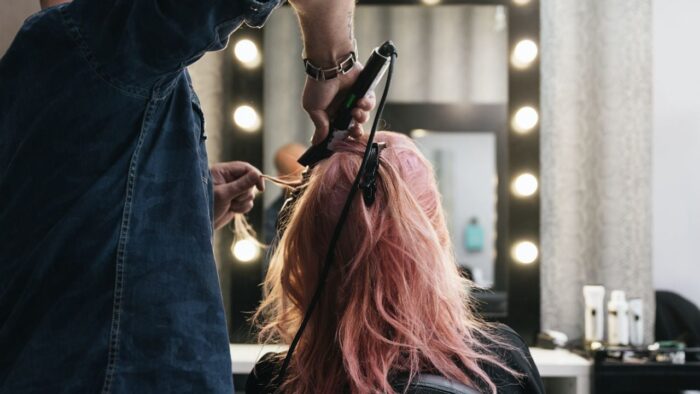Chemical hair straighteners have gained popularity for their ability to transform curly or frizzy hair into sleek, straight locks. However, beneath the allure of perfectly straight hair lies a potential risk to your health. It’s critical to recognize the risks of chemical-based hair straighteners and make educated decisions.
A new Drugwatch.com article discusses the findings of recent medical research that imply a relationship between the use of chemical hair straighteners and an increased long-term risk of breast cancer, uterine cancer, fibroids, and infertility. Furthermore, these harsh chemical treatments might also cause scalp discomfort and hair loss.
In this article, we will explore the health implications of these products.
Table of Contents
The Chemical Conundrum

Chemical hair straighteners contain strong ingredients that alter the hair’s structure and shape. Let’s take a closer look at the specific chemicals commonly found in these products:
1. Formaldehyde:
This chemical is often used in hair straighteners as a preservative and to maintain the straightened effect. Formaldehyde is a known human carcinogen, meaning it has the potential to cause cancer. When heated, formaldehyde is released as a gas, posing a risk of inhalation and subsequent health issues.
2. Sodium Hydroxide:
Sodium hydroxide, sometimes referred to as lye, is a highly alkaline chemical found in hair relaxers and straighteners. It disassembles the hair’s protein structure, allowing for reshaping. However, sodium hydroxide is a caustic material that, if handled improperly, can result in serious burns and skin damage.
3. Thioglycolates:
These chemicals are commonly found in permanent wave solutions, but they can also be present in hair straighteners. Thioglycolates break down the disulfide bonds in the hair, making it more pliable and allowing it to be straightened. They can, however, be irritating to human skin and have an unpleasant odor.
Concerns have been raised about the safety and potential health risks of some compounds included in hair straighteners. It’s important to note that not all chemical hair straighteners contain the same ingredients or concentrations, so the level of risk can vary between products.
Toxic Fumes and Lawsuits

Heated chemical hair straighteners release toxic fumes. Inhalation of these fumes over time can lead to chronic respiratory conditions such as asthma, bronchitis, and even several types of cancer. Several studies have highlighted the health risks associated with prolonged exposure to formaldehyde and other volatile organic compounds (VOCs) emitted by hair straighteners.
The number of research challenging the safety of hair straighteners has recently increased. In October 2022, the National Institutes of Health (NIH) published a study that pointed out that women who frequently use hair straighteners have more than double the chance of developing uterine cancer than women who do not.
As a result, many who have been harmed by these chemicals have taken legal action against the manufacturers of these hair straighteners. A hair straightener cancer lawsuit typically revolves around product liability claims.
According to TorHoerman Law, the plaintiffs argue that the manufacturers and distributors of these hair straighteners failed to adequately warn consumers about the potential health hazards associated with the products or provide sufficient safety measures to mitigate the risks.
Skin Sensitization and Allergic Reactions
Chemical hair straighteners contain ingredients that can irritate and sensitize the skin. Contact with these chemicals can cause redness, itching, and rashes on the scalp, face, and neck. Some individuals may even develop allergic reactions, experiencing severe itching, swelling, and blisters.
Allergic reactions to hair straighteners can persist long after exposure, making future product usage risky. It’s essential to conduct a patch test before using any chemical-based hair straightener. Apply a small amount to a small area of the skin and observe for any adverse reactions. If skin irritation or allergies occur, it’s crucial to seek medical attention.
Hair and Scalp Damage

Chemical-based hair straighteners can cause significant damage to your hair and scalp. The harsh chemicals cause the hair’s natural ties to dissolve and its protective oils to be stripped away, leaving it brittle, dehydrated, and prone to breaking. This can eventually lead to hair loss and thinning.
Additionally, the scalp may become irritated and itchy and develop dandruff due to the harsh ingredients in these products. The disruption of the scalp’s natural pH balance can also lead to an overgrowth of fungi or bacteria, further contributing to scalp issues.
Hormonal Disruption
Certain chemicals found in hair straighteners, such as phthalates and parabens, are known endocrine disruptors. These substances can interfere with the hormonal balance in your body, mimicking or blocking the actions of natural hormones.
Long-term exposure to endocrine disruptors has been associated with reproductive problems, hormonal abnormalities, and a higher chance of developing certain malignancies, such as breast cancer and prostate cancer.
Phthalates, specifically, are often used as plasticizers in hair straighteners to increase flexibility and durability. They have been associated with adverse effects on reproductive health, including decreased sperm count, infertility, and developmental abnormalities in offspring.
Long-Term Health Concerns

The cumulative exposure to harmful chemicals from repeated use of chemical hair straighteners can increase the likelihood of developing chronic health conditions.
Dermatological issues like chronic skin irritation, dermatitis, and eczema may arise from prolonged contact with the chemicals in hair straighteners. These conditions can cause discomfort, affect the quality of life, and require ongoing medical treatment.
Furthermore, a Stylecraze blog post states that straightening your hair can cause hair damage and lead to long-term consequences such as hair breakage and loss. The primary causes of these problems include excessive temperatures, incorrect technique, and chemical agents utilized in the straightening process.
Moreover, the potential hormonal disruption caused by certain ingredients in hair straighteners raises concerns about long-term health effects. Disruption of the endocrine system can have far-reaching consequences on reproductive health, thyroid function, metabolism, and overall hormonal balance.
In contrast, hair clippers for men offer a versatile and health-conscious approach to hair care and grooming. These handy tools have gained immense popularity in recent years for several compelling reasons. Unlike chemical hair straighteners, hair clippers provide a safe and effective means of managing various hairstyles, all while prioritizing your well-being. One of the standout advantages of hair clippers is the precise control they offer over hair length. Whether you’re looking for a clean shave, a close trim, or a stylish fade, clippers allow you to achieve the desired look with ease. This precision ensures that you can maintain your chosen hairstyle consistently, saving you both time and money on frequent salon visits.
Key Takeaways
Chemical hair straighteners may offer temporary beauty transformations, but they come with potential risks to your health. The presence of carcinogens like formaldehyde, caustic substances like sodium hydroxide, and skin irritants like thioglycolates raises concerns about the safety of these products.
The release of toxic fumes during the straightening process and the potential for respiratory conditions and cancer further highlight the dangers. Skin sensitization, hair and scalp damage, and hormonal disruption add to the list of health concerns.
It is crucial to prioritize informed decision-making and consider alternatives to chemical hair straighteners that prioritize both beauty and long-term health.

